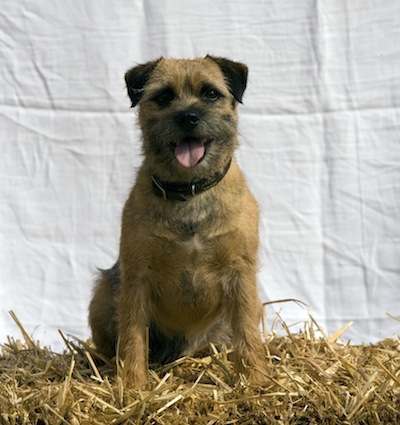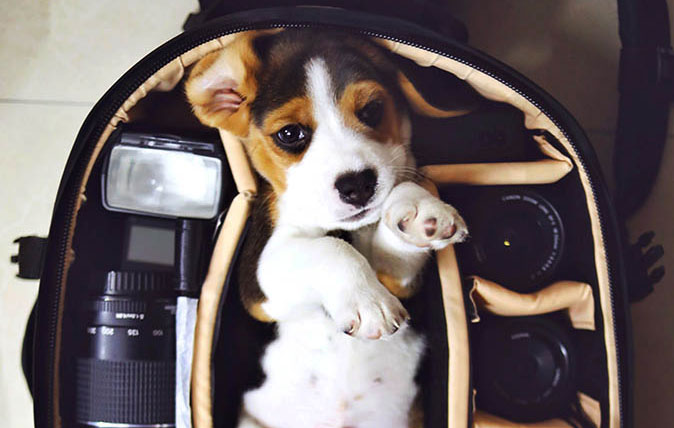The joys of the border terrier
Devotees say once you’ve had a border terrier, you’ll never look at another dog

If the border terrier were human, the elbows of his tweed jacket would be patched with leather, and he would spend his evenings reading hunting diaries in a smelly armchair. His appearance would be stocky, twinkly, whiskery and rural. He would be kind to children, but brook no nonsense from them; he would be an uncomplaining foot soldier, but he might be tricky to manage if denied intellectual stimulation.
Less bouncy than the Jack Russell, more rugged than the Norfolk, more assertive in stance than the Dandie Dinmont or the Bedlington-to which he's related-and more cuddly-looking than his neighbour, the Lakeland, the border's pansy-shaped face, wise, dark eyes and pepper-and-salt markings give him the enquiring, professorial air of an otter poking its whiskers above the water.
You can't get a much better endorsement for a breed than for the chairman of the Kennel Club (KC) to keep them. Steve Dean first encountered the game little dog 30 years ago, when he married a girl who bred them in a case of ‘love me, love my dogs'.
After his wife died, Prof Dean continued to produce borders, under the Tyrian prefix. He had 17 by the time he got married again, to Karen, who soon realised she'd have to share her husband. They currently have a round dozen at their Windsor home.
‘I call them the thinking-man's terrier,' says Prof Dean.
‘They're a big dog in a small package. A chap can feel happy walking a border down the road because he won't be laughed at. Borders don't know they're little.'

Jenny Jackson-Stops, an equestrian journalist, was determined to have a border as soon as her work permitted. ‘I was brought up with them. As we were a family of four children, it had to be a small dog to fit in the car, and my mother got the idea of a border from seeing a friend's cheerful little dog zooming from sofa to sofa as if it were on a cross-country course.'
Exquisite houses, the beauty of Nature, and how to get the most from your life, straight to your inbox.
She was distraught at losing her first dog when it was killed by a fox, but now has Bonny, found through an advertisement in Horse & Hound, who has even won over her reluctant husband, Tim. ‘They're such a good mix of sporting and domestic. She runs behind my polo pony, staying with me for the whole ride, and when I went wild swimming in a friend's lake, she leapt straight off the jetty. She's adorable at home-Tim, who is not a dog lover, is besotted.'
Althea Gifford, a racehorse trainer's widow and mother, also grew up with the breed. Her son Nick's dog, Barnaby, goes with her when she rides out every day. ‘One minute, he's out of sight and you think he's left behind; the next, he comes happily trotting over the horizon and is right beside you.'
Althea gave her daughter, Kristina Cook, a member of Britain's Olympic eventing team, a border called Rusty as a 21st-birthday present to alleviate homesickness when she won a riding scholarship to train with Mark Phillips. She now has Rusty's successor, Finn.
The eventer's preferred accessory is generally a Jack Russell, but she says: ‘I love my border-he's a great character, but without being as yappy as some other terriers, and he's the perfect lorry dog.'

Former army wife Richenda Miers is ‘besotted' with the breed, and as soon as she had a permanent home, she took on a friend's dog. ‘After that, we couldn't have had any other sort,' she explains. ‘Once you've had one, you'll be hooked. They're half-human, gentle, kind, polite, loving.' Mrs Miers names her borders after Burns characters-the current one is Souter Johnnie from Tam O'Shanter.
She cautions: ‘They do have attitude. There's a little built-in corner of their brain you can't change, however well you train them. If their hunting instinct is aroused, there's nothing you can do.' Souter has another interesting habit. ‘He has little mad moments, usually at night. They're definitely related to the phases of the Moon.'
Evidence of Moon madness was hard to corroborate, but many owners report a hound like predilection for group singing. ‘We call it choir practice,' says Prof Dean. ‘It's definitely orchestrated; each dog knows when to chime in, but they don't like humans to be present and shut up when we come in.'

News of the border's charms has spread rapidly, and, as with any newly fashionable breed, it's not an entirely good thing. Fifteen years ago, fewer than 900 were registered with the KC. Then, in 1988, a border was reserve best in show at Crufts, and the rise began. Now, the border accounts for 25% of the 28,000 terriers registered with the KC in 2011, and is more popular than the ubiquitous Staffordshire.
The comedian David Walliams has one called Bert, and tennis player Andy Murray owns Rusty and Maggie May (who has her own Twitter account). In Coronation Street, Ken Barlow has been playfully tormented by a border, Eccles, who chewed up his newspapers and adopted his favourite chair; Lord Kilwillie in Monarch of the Glen had two. Borders appear in films from Lassie to There's Something About Mary, and even in the current sci-fi blockbuster Prometheus.
As far back as 1920, the formation of the Border Terrier Club (BTC) and its affiliation to the KC was hotly debated, with some aficionados believing the breed would be ruined if it became a show dog. It's greatly to the credit of the organisation that the official breed standard still reads ‘Essentially a working terrier' and adheres to strictures set nearly a century ago.
The dog was originally bred in the 18th century by farmers, shepherds and field sportsmen to keep up with the Border Foxhounds all day and still have enough energy when the hunted fox had gone to ground to bolt it from its earth. Although this practice was banned under the Hunting Act (2004), there is a clause-known as ‘the gamekeeper's exemption' which says a terrier may be worked underground ‘where there is a threat to game birds or wild birds'. The BTC still issues working-dog certificates, and classes are available for dogs with those qualifications.
‘Borders were once just an unknown little brown terrier,' explains Prof Dean. ‘They started to explode in popularity, and when the pet industry finds them, that's where problems start.
'The breed had always been under the control of enthusiasts; now, they're coming out of puppy farms and being promoted as Christmas presents-no decent border person would produce puppies at Christmas-time. However, the breed clubs are a close-knit community and the rescue organisations do a fantastic job.'
Renfrewshire vet Eddie Houston, chairman of the BTC, agrees. ‘The border is almost a victim of its own success. The basic dog has changed very little and that's part of their appeal, but some of their traits aren't convenient for modern owners.
'They're affectionate and good-tempered, but you don't want them near guinea pigs or rabbits. Some people, who shouldn't be owning dogs anyway, see them as little fluffy things, rather than as dogs with a dog's instincts.'
He adds: ‘We now have cases of indiscriminate breeding and specimens that aren't very good because we live in a society that wants instant gratification. Instead of waiting for a puppy from a registered breeder, people go online to a pet-shopping site. The result is more dogs ending up at Border Terrier Welfare or in municipal dog pounds.'
The border looks adorable, but his oily, wiry coat will spread everywhere if you don't get him properly hand-stripped. They can be greedy, and will run to fat if not watched. In Border Terriers: An Owner's Companion, authors Frank and Jean Jackson suggest that the dogs ‘should not be left to their own devices in a garden which is any less secure than Alcatraz'.
And the BTC states: ‘Although he will willingly become part of your family, he does have some traits which may not always endear him to you. He is inclined to chase small critters, and it is not always easy to train him to distinguish between the rat you would like despatched and your child's pet hamster.'
Flowerbeds and new shoes are also fair game, and Prof Dean reports that one of his dogs scaled a 12ft fence to get to a bitch on the other side. Borders are good at dog-agility competitions, but they don't always act on command like the border collie, and, although they don't tend to pick fights, they don't forget an enemy in a hurry either. Mr Houston sums up: ‘It's a great testament to the breed that it can double up as a working dog and a family pet, but they do need training from the start with a firm but kind hand. They're cracking little dogs, but they're not accessories. They deserve the best we can give them.'
The Border Terrier Club (0191-371 9405; www.theborderterrierclub.co.uk) Border Terrier Welfare has branches across the country (www.borderterrierwelfare.org.uk)

Country Life readers dogs’ picture gallery
Country Life is unlike any other magazine: the only glossy weekly on the newsstand and the only magazine that has been guest-edited by His Majesty The King not once, but twice. It is a celebration of modern rural life and all its diverse joys and pleasures — that was first published in Queen Victoria's Diamond Jubilee year. Our eclectic mixture of witty and informative content — from the most up-to-date property news and commentary and a coveted glimpse inside some of the UK's best houses and gardens, to gardening, the arts and interior design, written by experts in their field — still cannot be found in print or online, anywhere else.
-
 A Georgian farmhouse that's an 'absolute gem' in an ancient village on Salisbury Plain
A Georgian farmhouse that's an 'absolute gem' in an ancient village on Salisbury PlainJulie Harding takes a look at the beautiful West Farm in a gorgeous Wiltshire village.
-
 Can you guess the landmark from its gingerbread copy cat? Take our quiz
Can you guess the landmark from its gingerbread copy cat? Take our quizToday's quiz takes a detailed look at the gingerbread works on display at London's The Gingerbread City — and asks if you can guess which iconic landmark they are.
